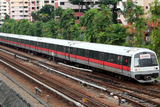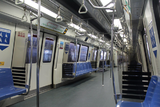Kawasaki Heavy Industries & Nippon Sharyo 751B
Kawasaki Heavy Industries & Nippon Sharyo C751B are the third generation of trains running on the North–South Line and the East–West Line. These trains were manufactured from 1999 to 2001 by Kawasaki Heavy Industries and Nippon Sharyo, with only 1 difference despite having built to agreed specifications.
History
The C751B trains were bought mainly to complement the existing trains due to the opening of the Changi Airport Extension on the East West Line. These trains began revenue service in 2001.
Some of the trains had luggage racks installed in every carriage of the train, taking up the space of two seats next to the door at the end of each carriage. The purpose of those racks were to let travellers heading to the airport, who usually carry a large amount of luggage, to have a space to place their bags easily.
However, these luggage racks were always underutilised. Travellers preferred holding on to their bags where they were standing or sitting, as opposed to placing them on the luggage racks, probably due to convenience and fear of theft. Some commuters were also complaining that these racks took up critically needed space which could be occupied by other passengers which often filled the train. Furthermore, the through train service to Changi Airport was replaced by a shuttle service, dismissing the need to provide these racks for non-airport bound train services. Therefore, trains with the luggage racks had them removed in 2003, leaving an empty standing area, with a purpose of serving as a wheelchair area.
Fragmented Gearbox
On 13 April 2002, a fault was detected in a train and was subsequently withdrawn to Changi Depot for investigations. As the trains was under warranty, the engineers from the manufacturers of the train and gearbox were flown in on 21 April. They subsequently detected metal fragments in the gearboxes, and those of another 20 trains. SMRT immediately withdrew all 21 trains and suspended the through train service, replacing it with the shuttle service. Train frequencies were also adjusted until early May, when 8 trains returned to service. By end of May 2002, all trains had been returned to service and the through service was resumed.[1]
Design/Features
Passenger Trains
| Kawasaki Heavy Industries | Nippon Sharyo | |
|---|---|---|
DT M1 M2 M2 M1 DT
| ||
| Exterior Design | ||
| Livery | Black,Red,Grey (Top to bottom) | |
| Train Run Number | Orange LED | |
| Interior Design | ||
| Seating Capacity | 276 (272 after signalling upgrade) | 288 (284 after signalling upgrade) |
| Wheelchair Bay | 12, 1 each at either end of a car | 6, 1 each per car |
| Door Closing Indicator Lights | 4 Red LED (Side) | |
| Passenger Information System | Visual Passenger Information System ( SMRT Active Route-map and Information System (Dynamic Route Map + VFD display) | |
| System | ||
| Safety System | ATC, ATO, ATP, ATS (after signalling upgrade) | |
| Signalling System | Fixed Block Communication Based Train Control (after signalling upgrade) | |
| Traction Control | IGBT-VVVF (Fuji Electric) | |
Fleet Numbering
The car numbers of the trains range from x311 to x352, where x depends on the carriage type.
- The first digit identifies the position of the car from the closest end of the train; where ‘3’ represents first car, ‘1’ represents second car and ‘1’ represents third car.
- (Example) Passenger Vehicle 351/352 would consist of 6 cars with serial number 3351, 1351, 2351, 2352, 1352 and 3352 respectively.
- Depending on the direction of travel, the sequence may be reversed.
References
- ↑ "21 MRT trains withdrawn Longer wait for trains". The New Paper (23 April 2002). Retrieved 29 July 2018.
| [ V • T • E ] | ||
|---|---|---|
| Overview | History • Stations • Fare and Ticketing • Facilities • Safety • Security | |
| Lines | North–South Line • East–West Line • North East Line • Circle Line • Downtown Line • Thomson–East Coast Line
FutureJurong Region Line • Cross Island Line | |
| Rolling Stocks | 151 • 151A • 151B • 151C • R151 • T251 • 751A • 751C • 830 • 830C • 851E • 951
Future J151 • CR151 | |
| Depots | Bishan • Changi • Gali Batu • Kim Chuan • Mandai • Sengkang • Ulu Pandan • Tuas | |
| Future Changi East • East Coast • Tengah | ||

